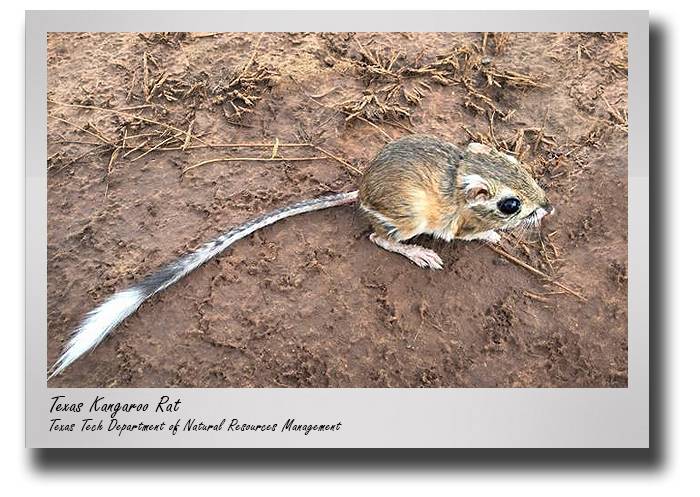NRM’s Boal to study Texas Kangaroo Rat habitat connectivity, management
By: George Watson
 An ecosystem can encompass hundreds, if not thousands, of different species, from
plant life to the animals that inhabit it. All these different species work to get
what they can out of the ecosystem, taking nutrients from the ground and larger organisms
feeding on some of the smaller ones. But, somehow, most, if not all, the species manage
to survive, and some even thrive.
An ecosystem can encompass hundreds, if not thousands, of different species, from
plant life to the animals that inhabit it. All these different species work to get
what they can out of the ecosystem, taking nutrients from the ground and larger organisms
feeding on some of the smaller ones. But, somehow, most, if not all, the species manage
to survive, and some even thrive.
 But the alteration and eradication of rangeland over time has made survival difficult
for some species, so some land on the Texas Parks & Wildlife Department's threatened
list. One of those is the Texas Kangaroo Rat.
But the alteration and eradication of rangeland over time has made survival difficult
for some species, so some land on the Texas Parks & Wildlife Department's threatened
list. One of those is the Texas Kangaroo Rat.
Not much is known about the habitat use of the Texas Kangaroo Rat, and what is known is associated primarily with burrowing sites, with little data on foraging areas and home range conditions. Even the method of dispersal of the rat into new areas has yet to be determined. A researcher at Texas Tech University is hoping to change that.
Clint Boal, a professor in Texas Tech’s Department of Natural Resources Management, recently received a $277,982 grant from the U.S. Department of the Interior's Fish and Wildlife Service and the TPWD to study the connectivity and management of, and develop monitoring strategies for, the Texas Kangaroo Rat.
“This is an opportunity for us to work directly with landowners and learn to manage private lands to further conservation efforts for the Texas Kangaroo Rat in ways that are compatible with livestock production and good rangeland management,” Boal said.
The project is a collaborative effort with associate professor Carlos Villalobos and Richard Stevens, the President's Excellence in Research Professor in NRM. Stevens earned a grant from the Texas Comptroller of Public Accounts to study the spatial ecology of the Texas Kangaroo Rat.
The goal of Boal's project is to determine how best to survey and monitor Texas Kangaroo Rats and develop a fine-scale understanding of their habitat use, home range size and pattern of dispersal. The hope is to establish best practices for private landowners so their rangeland can serve as a Texas Kangaroo Rat habitat while supporting livestock production.
 The rats, which are typically about the size of a gerbil, will be assessed for their
movement and habitat use on private lands and state park/wildlife management areas
in several counties surrounding Wichita Falls. Surveys will be conducted to determine
where the rats are most abundant during the week of the new moon when the kangaroo
rat is most active. Once the different detection methods have been evaluated for time,
cost efficiency and maximum detection, those methods will be applied to the Texas
Kangaroo Rat.
The rats, which are typically about the size of a gerbil, will be assessed for their
movement and habitat use on private lands and state park/wildlife management areas
in several counties surrounding Wichita Falls. Surveys will be conducted to determine
where the rats are most abundant during the week of the new moon when the kangaroo
rat is most active. Once the different detection methods have been evaluated for time,
cost efficiency and maximum detection, those methods will be applied to the Texas
Kangaroo Rat.
 Researchers will then use GPS data-transmitting collars to determine the different
dispersal behaviors. Most species occupy a new area through the dispersal of their
juveniles, but this has not been confirmed as the method of dispersal for the Texas
Kangaroo Rat. These collars will allow researchers to collect fine-scale habitat information
for up to two months. Once enough data has been collected, researchers will evaluate
the occupied locations to determine such factors as soil type and condition and vegetation
composition in order to conduct future research.
Researchers will then use GPS data-transmitting collars to determine the different
dispersal behaviors. Most species occupy a new area through the dispersal of their
juveniles, but this has not been confirmed as the method of dispersal for the Texas
Kangaroo Rat. These collars will allow researchers to collect fine-scale habitat information
for up to two months. Once enough data has been collected, researchers will evaluate
the occupied locations to determine such factors as soil type and condition and vegetation
composition in order to conduct future research.
Researchers will then engage in experimental manipulation of vegetation in unoccupied areas to establish a Texas Kangaroo Rat habitat that is in proximity to existing rat clusters to urge the species to expand into and occupy new territory.
Some rangeland will undergo controlled grazing while other rangeland will undergo prescribed fire followed by grazing. This will determine whether rangeland managers can expand habitat use in a way that is beneficial both to the rat and to other species on the land, specifically cattle.
CONTACT: Warren Conway, Bricker Endowed Chair in Wildlife Management and Chairperson, Department of Natural Resources Management, Texas Tech University at (806) 4-6579 or warren.conway@ttu.edu
0816NM21 / PHOTO: John Stuhler - CASNR NRM
Davis College NewsCenter
-
Address
P.O. Box 42123, Lubbock, Texas 79409-2123, Dean's Office Location:Goddard Building, Room 108 -
Phone
(806)742-2808 -
Email
kris.allen@ttu.edu
